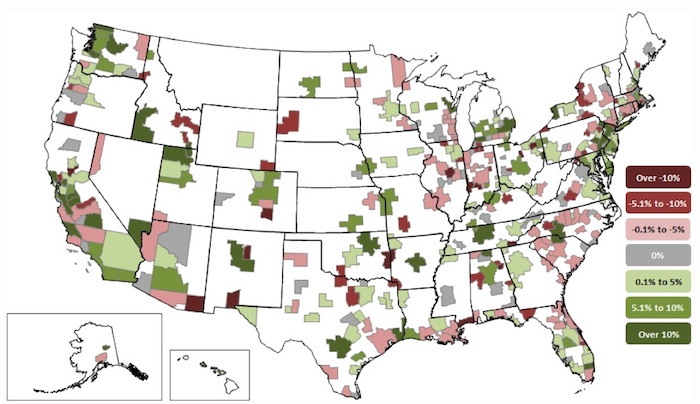Labor shortage chokes construction industry
While building activity increased, construction jobs declined between September 2014 and September 2015.
- Fort Worth-Arlington, Texas and Las Cruces, N.M. Experience the Largest Declines for the Year;
- Phoenix-Mesa-Scottsdale, Ariz. and Weirton-Steubenville, W.V.-Ohio Top Growth List
Construction employment declined in 144 out of 358 metro areas between September 2014 and September 2015, while construction activity increased in 159 metro areas, according to a new analysis of federal employment data released today by the Associated General Contractors of America.
| U.S. Construction Employment Change, Sept. 2014 to Sept. 2015 |
 |
Association officials said many contractors are having a hard time finding qualified workers to fill available positions, which may account for the underwhelming employment figures.
“It appears that many of these job losses have more to do with a lack of workers than they do a lack of work,” said Stephen E. Sandherr, the association’s chief executive officer. “While some markets are seeing a softening in demand, overall construction spending continues to rise while the sector’s unemployment rate continues to fall.”
The largest job losses from September 2014 to September 2015 were in:
- Fort Worth-Arlington, Texas (-6,200 jobs, -8 percent)
- Houston-The Woodlands-Sugar Land, Texas (-3,300 jobs, -2 percent)
- Bergen-Hudson-Passaic, N.J. (-2,700 jobs, -9 percent)
- New Orleans-Metairie, La. (-1,700 jobs, -5 percent)
- Akron, Ohio (-1,600 jobs, -12 percent)
The largest percentage decline for the past year was in Las Cruces, N.M. (-17 percent, -600 jobs), followed by Lawrence-Methuen Town-Salem, Mass.-N.H. (-17 percent, -400 jobs), Sierra Vista-Douglas, Ariz. (-17 percent, -200 jobs) and Gulfport-Biloxi-Pascagoula, Miss. (-16 percent, -1,400 jobs).
Phoenix-Mesa-Scottsdale, Ariz. (8,200 jobs, 9 percent) added the most construction jobs during the past year.
Other metro areas adding a large number of construction jobs include:
- Denver-Aurora-Lakewood, Colo. (7,900 jobs, 8 percent),
- Seattle-Bellevue-Everett, Wash. (6,900 jobs, 8 percent) and
- Los Angeles-Long Beach-Glendale, Calif. (6,800 jobs, 6 percent).
The largest percentage gains occurred in:
- Weirton-Steubenville, W.Va.-Ohio (33 percent, 600 jobs);
- Fairbanks, Alaska (19 percent, 600 jobs);
- Wenatchee, Wash. (17 percent, 400 jobs) and
- Boise City, Idaho (16 percent, 2,800 jobs).
Association officials noted that 86 percent of firms that participated in a recent association survey reported having a hard time finding qualified workers to fill available positions. They urged federal, state and local officials to boost funding for career and technical education and make it easier to establish construction-focused high school programs and for firms to establish their own training programs.
“The sad fact is our educational system is doing a great job of preparing students for jobs that don’t exist and a lousy job getting them prepared for high paying jobs like construction that do exist,” said Sandherr. “Until we have an educational and training system that is aligned to economic reality, construction projects are likely to cost more and take longer to complete.”
Source: AGC.org
















